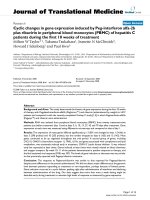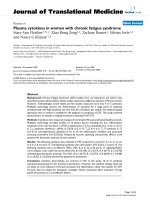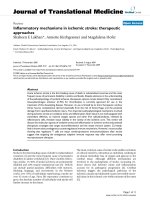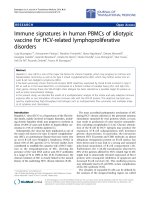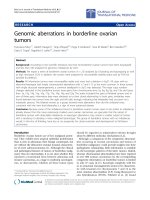báo cáo hóa học: " Microglia activation in sepsis: a case-control study" ppt
Bạn đang xem bản rút gọn của tài liệu. Xem và tải ngay bản đầy đủ của tài liệu tại đây (1.1 MB, 8 trang )
BioMed Central
Page 1 of 8
(page number not for citation purposes)
Journal of Neuroinflammation
Open Access
Research
Microglia activation in sepsis: a case-control study
Afina W Lemstra*
1
, Jacqueline CM Groen in't Woud
1
,
Jeroen JM Hoozemans
2
, Elise S van Haastert
2
, Annemiek JM Rozemuller
2
,
Piet Eikelenboom
1
and Willem A van Gool
1
Address:
1
Department of Neurology, Academic Medical Centre, PO Box 22660, 1100DDAmsterdam, The Netherlands and
2
Department of
Neuropathology, Academic Medical Centre, PO Box 22660, 1100DDAmsterdam, The Netherlands
Email: Afina W Lemstra* - ; Jacqueline CM Groen in't Woud - ;
Jeroen JM Hoozemans - ; Elise S van Haastert - ;
Annemiek JM Rozemuller - ; Piet Eikelenboom - ; Willem A van Gool -
* Corresponding author
Abstract
Background: infection induces an acute phase response that is accompanied by non-specific
symptoms collectively named sickness behavior. Recent observations suggest that microglial cells
play a role in mediating behavioral changes in systemic infections. In animal models for sepsis it has
been shown that after inducing lipopolysaccharide, LPS, microglia in the brain were activated. The
aim of this study was to investigate whether activation of microglia can be detected in patients who
died of sepsis.
Methods: in a case-control study brain tissue of 13 patients who died with sepsis was compared
with that of 17 controls. Activated microglia were identified by expression of MHC-class II antigens
and CD68. Microglia activation was analyzed by a semiquantitative score combining both the
number of the immunoreactive cells and their morphology.
Results: in patients who died with sepsis there was a significant increase in activated microglia in
the grey matter when stained with CD68 compared to controls. This effect was independent of the
effect of age.
Conclusion: this study shows for the first time in human brain tissue an association between a
systemic infection and activation of microglia in the brain. Activated microglia during sepsis could
play a role in behavioral changes associated with systemic infection.
Background
Infection by pathogenic microorganisms triggers an acute
phase response which manifests itself with fever, neuro-
endocrine changes and behavioral changes. The non-spe-
cific symptoms accompanying severe infection such as
malaise, fatigue, anorexia, hypo-and hypersomnia,
depression and lethargy, are collectively referred to as sick-
ness behavior[1,2].
The pathophysiological mechanisms underlying sickness
behavior remain to be elucidated. Several studies suggest
that pro-inflammatory cytokines such as tumor necrosis
factor α (TNF-α), interleukin (IL)-1 and IL-6 induce these
Published: 15 January 2007
Journal of Neuroinflammation 2007, 4:4 doi:10.1186/1742-2094-4-4
Received: 18 October 2006
Accepted: 15 January 2007
This article is available from: />© 2007 Lemstra et al; licensee BioMed Central Ltd.
This is an Open Access article distributed under the terms of the Creative Commons Attribution License ( />),
which permits unrestricted use, distribution, and reproduction in any medium, provided the original work is properly cited.
Journal of Neuroinflammation 2007, 4:4 />Page 2 of 8
(page number not for citation purposes)
responses[3,4]. Experiments in both animals and humans
showed that administering cytokines and lipopolysaccha-
ride (LPS, the active fragment of Gram-negative bacteria)
peripherally or directly in the brain, causes cognitive
impairments and behavioral disturbances[2,5-9]. Some
observations suggest that microglial cells play a role in
mediating behavioral changes in systemic infections.
Microglia are considered the macrophages of the brain
which can be triggered from a resting state into an acti-
vated state by exogenous stimuli. Activation in this con-
text means that microglia change their morphology and
upregulate and express antigens. Semmler et al. showed
that in rats a peripheral inflammatory reaction induced by
LPS, as a model for sepsis, lead to profound activation of
glial cells in the brain, including microglia[10]. Mattiace
et al described upregulation of cell surface antigen on
microglia in patients with Alzheimer's disease and carci-
nomatosis with concomitant infection[11].
We analyzed in a case-control study the distribution of
immunophenotype of microglia in brain tissue from
patients with sepsis, defined as the presence of both
microbiologically confirmed infection and a systemic
inflammatory response. In this study we present the first
evidence for microglia activation in the human brain asso-
ciated solely with a systemic inflammatory reaction.
Materials and methods
Selection of cases and controls
Data were obtained of all brain autopsies that had been
performed on patients who died in the Amsterdam Medi-
cal Centre (AMC) in the period of the year 2001 to the
year 2005. In total the autopsy reports of 170 patients
were studied.
Patients were selected by the following criteria: permis-
sion for use of autopsy material for research purposes,
presence of frontal and parietal brain tissue and absence
of signs of CNS infection and supratentorial pathology
including gliosis and senile changes (Figure 1).
Thirty-six patients fulfilled these criteria and were subse-
quently screened for having sepsis at the time of death. A
patient was considered to have died with sepsis if blood
cultures were positive up to 7 days before death or if post-
mortem cultures (spleen, kidney or lung) were positive.
Supporting evidence for sepsis was collected from medical
records and computerised laboratory charts. This com-
prised clinical signs as fever and tachycardia and labora-
tory findings such as leucocytosis and elevated CRP
according to the international consensus criteria for the
definition of sepsis[12]. In total 13 patients were selected
as cases.
Patients were classified as control if sepsis at time of death
was highly unlikely. This was determined by negative cul-
tures (saliva, urine, blood, faeces and post-mortem), nor-
mal CRP and white blood cell count 0 to 3 days before
death and/or no signs of infection in the autopsy report.
In total 17 patients were considered suitable controls. The
predominant cause of death in controls was of cardiac or
circulatory origin (Table 1). From all patients brain tissue
from frontal and/or parietal regions was derived and used
for analysis.
Immunocytochemistry/immunohistochemistry
For the immunohistochemical stainings 4% formalin
fixed, paraffin-embedded tissue from the neocortex was
used. Brain tissue samples were selected that contained
frontal and/or parietal cortex and the adjacent sub-cortical
white matter. Sections (7 μm) were mounted on APES
coated (frost plus) tissue slides and deparaffinised. Subse-
quently sections were immersed in 0.3% H
2
O
2
in metha-
nol for 30 minutes to quench endogenous peroxidase
activity. For antigen retrieval, sections were pretreated in
10 mM pH 6.0 citrate buffer and heated by autoclave for
10 minutes. Serum and antibodies were dissolved in
phosphate-buffered saline (PBS). Sections were pre-incu-
bated for 30 minutes with 10% normal goat-serum
(DAKO, Glostrup, Denmark) and subsequently incubated
with the primary antibodies (4°C overnight). As primary
antibodies anti-Human Leukocyte Antigen (HLA)-DP, -
DQ, -DR (mouse monoclonal, clone CR3/43, DAKO;
1:100) and anti-CD68 (mouse monoclonal, clone PG-
M1, DAKO, 1: 200) were used. For the detection of mouse
antibodies ready-for-use Power Vision (ImmunoLogic,
Duiven, the Netherlands) was used according to the
instructions of the manufacturer. Before use Powervision
solutions were diluted 1:1 in PBS. Color was developed
using 3,3'-diaminobenzidine (0.1 mg/ml, 0,02% H
2
O
2
, 3
min.) as chromogen and nuclei were stained with haema-
toxylin. Sections were mounted with Entellan (Merck,
Darmstadt, Germany).
Evaluation of immunostaining
A semi-quantitative assessment of microglial immunore-
activity in the parenchyma for CD68 and MHC-class II
antigens was carried out. All sections were evaluated inde-
pendently by three observers blinded for case number and
clinical information. One representative section was
assessed for each patient at ×20 magnification after which
a 3-field count was performed at ×40 magnification. Cor-
tical fields were selected so that all cortical layers were
included. White matter fields included both "sub grey
matter" as well as deep white matter. Immunostainings
for CD68 and MHC-class II antigens were rated on a three
point scale. For the rating both the number of immunop-
ositive cells and morphological changes were taken into
account. Grey matter and white matter were rated inde-
Journal of Neuroinflammation 2007, 4:4 />Page 3 of 8
(page number not for citation purposes)
pendently. For the grey matter the following scoring defi-
nitions were applied: score 1 = less then 5
immunoreactive cells; score 2 = between 5 and 15 immu-
noreactive cells of which less than 25% with an amoeboid
morphology; score 3 = more than 15 immunoreactive
cells of which more than 25% have an amoeboid mor-
phology. For the white matter the following definitions
were applied: score 1 = less than 10 immunoreactive cells;
score 2 = between 10 and 25 immunoreactive cells of
which less than 25% with an amoeboid morphology;
score 3 = more than 25 immunoreactive cells of which
more than 25% have an amoeboid morphology. For score
1 no notice of amoeboid cells was made. For score 3 each
section had to fulfill both criteria: more than 15 (grey
matter) or 25 (white matter) immunoreactive cells and
more than 25% amoeboid morphology. Sections only
meeting one of these criteria were classified as score 2. Fig-
ure 2 shows representative pictures of the different immu-
noreactive scores.
In sections with area variations in the density of immuno-
reactive cells in the studied specimen an average score was
given after reaching consensus between the three observ-
ers. Perivascular macrophages were noted separately but
not included in the final evaluation since parenchymal
changes were the object of interest. Some sections showed
immunoreactive staining of endothelia as well as appear-
ance of small clusters (40–60 μm) of microglia in the grey
matter. These were noted separately but not included in
the semi-quantitative score.
Flow chart of selection of cases and controlsFigure 1
Flow chart of selection of cases and controls. * Questionable cases: systemic diseases or diseases with a (possible) effect
on the central nervous system/brain (HIV-infection, non-Hodgkin lymphoma, lungcancer)
Journal of Neuroinflammation 2007, 4:4 />Page 4 of 8
(page number not for citation purposes)
Statistics
SPSS for Windows was used for statistical analysis of the
data. Mann-Whitney U test for non-parametric testing was
used to assess differences between groups.
Because of the nature of the outcome variable (i.e. micro-
glia activation score) an ordinal regression model was
used to predict effects of independent variables available
through SPSS procedure PLUM (polytomous logit univer-
sal models).
A value of P < 0.05 was considered statistically significant.
Results
Cases and controls
Demographic characteristics of cases and controls are
listed in Table 2. There were no differences in sex and in
time from death until autopsy between cases and controls.
There was a difference of 9.3 years in the mean age
between the two groups, of which the controls were
younger.
Qualitative analysis of the immunostaining
Cells of the microglia/macrophage cell system were
immunohistochemically identified in both cases and con-
trols. Microglia cells were diffusely distributed throughout
the parenchyma. In agreement with other reports the
number of microglia was in general higher (about two
times) in the white matter than in the cortex. Immunore-
activity was also observed in the perivascular space but
was not taken into account for further quantitative analy-
sis. Next to microglia, endothelial cells stained positive in
2 cases and in 2 controls. Some clustering of microglia was
observed in a few specimen in both cases and controls.
Semi-quantitative analysis of the distribution of
immunoreactive parenchymal cells
In 9 of the 13 sepsis patients (69%) a diffuse distribution
of CD68 immunoreactivity with a high number of posi-
tive cells with an amoeboid (or macrophage-like) appear-
ance was observed in the cortex. Only 1 case (8%) showed
a low number of microglia that were mainly in the resting
state (score 1) compared to 6 of the controls (35%). The
differences in the proportion of CD68 positive cells
between the cases and controls in the CD68 immunos-
taining were significant both in the cortex (p = 0.002) and
in the white parenchyma (p = 0.011) (Fig 3A&B).
The typical staining pattern for the MHC-class II antigens
was clearly seen: the contour of the microglia was stained
which made the cell processes more visible. In contrast to
the results of the CD68 staining, there was no significant
difference between cases and controls in the proportions
of MHC-class II immunoreactive cells: cortex p = 0.239,
white parenchyma p = 0.588 (Fig 3C&D).
Microglia activation and age
In order to investigate if the difference in mean age
between our cases and controls could explain the
observed differences in CD68 immunostaining we did an
ordinal regression analysis with the level of microglial
activation as dependent variable, group as factor and age
as covariate. In this model having sepsis had a significant
and independent effect on microglia activation when
CD68 positive cells were observed in both grey and white
matter (p = 0.009 and p = 0.013 resp.). Age also had a sig-
nificant effect on microglia activation when stained with
CD68 but only in grey matter (p = 0.021). The parameter
estimates of respectively age and having sepsis were 0.069
and 2.329 in the model for CD68 in grey matter.
Discussion
In animal studies it has been shown that when sepsis is
experimentally induced by LPS injection, microglia in the
brain become activated[10]. Our aim was to replicate this
finding in human tissue. In this study we describe for the
first time a marked increase of activated microglia in brain
tissue of patients who died with sepsis. This case-control
study was conducted in an unbiased autopsy sample
which adds to the external validity of our results. We used
the antibody CD68 and MHC-class II antigens which are
widely used markers for microglia activation. In addition
to immunophenotype, the morphology of the microglia
was taken into account for the microglia activation score.
The CD68 expression on microglia was significantly
higher in the septic patients compared with the controls
and more amoeboid formed microglia were seen. We did
not find a significant difference between sepsis patients
and controls when MHC-class II immunoreactivity was
observed.
Table 1: Cause of death in controls
Pt.nr Cause of death
1Arrhythmia
2 Cardiac failure
3 Dying heart (trauma)
4 Brain herniation due to Arnold-Chiari malformation
5 Acute heartfailure
6 Myocardial infarction
7 Cardiac failure
8 Haemorrhagic shock
9 Myocardial infarction
10 Haemorrhagic shock
11 Haemorrhagic shock
12 Euthanasia (endometrial carcinoma)
13 Cardiopulmonary insufficiency
14 Haemorrhagic shock
15 Myocardial infarction
16 Myocardial infarction
17 Haemorrhagic shock
Journal of Neuroinflammation 2007, 4:4 />Page 5 of 8
(page number not for citation purposes)
There was a difference of 9.3 years in the mean age of the
sepsis-group compared to the control-group. This could
have influenced our results. When we investigated the
effects of sepsis and age in an ordinal regression model for
CD68 immunoreactivity there was a independent and sig-
nificant effect of sepsis on microglia activation next to the
effect of age.
In the present study the mean age in both cases and con-
trols was fairly high. This could explain why we found a
Immunohistochemical detection and immunoscore classification; left column shows CD68 grey matter (A, C & E) and right col-umn shows MHC-class II in white matter (B, D, & F); top is score 1, middle is score 2 & bottom is score 3 (see Materials & Method section)Figure 2
Immunohistochemical detection and immunoscore classification; left column shows CD68 grey matter (A, C & E)
and right column shows MHC-class II in white matter (B, D, & F); top is score 1, middle is score 2 & bottom is score 3 (see
Materials & Method section). Shown are ×40 magnification microscopic fields of representative immunohistochemical stainings;
all pictures are from sepsis patients, except for C. Insets show the morphological change of microglia.
Journal of Neuroinflammation 2007, 4:4 />Page 6 of 8
(page number not for citation purposes)
discrepancy between the results of the CD68 and the
MHC-class II immunoreactivity. CD68 is a lysosomal
membrane marker and stains microglia in a highly active,
phagocytising state [13-15]. HLA-DP,-DQ,-DR is an anti-
body directed against MHC-class II antigens and stains
microglial cells with great morphologic heterogeneity,
irrespective of the level of activation[16].
Microglia usually remain in a ramified resting form but
age may alter this quiescent state as is seen by an upregu-
lated MHC-II expression [17-19]. It has already been sug-
gested that MCH-II expression is a marker of cell aging in
addition or even instead of being an activation marker
[19,20]. Since our study population is relatively old,
MHC-II staining could partly reflect also microglial senes-
cence and therefore not yield significant differences
between sepsis and controls, due to a ceiling effect. Our
results could reflect an exaggerated microglial activation
caused by sepsis, as is shown by CD68-immunostaining,
in addition to the effect of aging which is expressed by the
MHC-class II immunoreactivity.
Several limitations are connected to this study. Data were
collected retrospectively; therefore sepsis in the cases as
well as the absence of a systemic inflammatory response
in controls could not be uniformly defined in all patients
as could have been done in a prospective study. There
were differences in the time that elapsed between cultures
and death of the patients and in some patients more clin-
ical data would have been helpful. Technical factors like
Table 2: Patients characteristics
Cases Controls
Number 13 17
Age (years) 71.2 (37 – 92) 61.9 (40 – 85)
Sex (male : female) 6 : 7 8 : 9
Post mortem time (hours) 23.6 (6.0 – 63.0) 29.5 (7.0 – 77.0)
Distribution of microglial activation scores in septic patients and controls in cortex and white matter after immunohistochem-ical staining for CD68 (A, B) and MCH-class II antigens (C, D)Figure 3
Distribution of microglial activation scores in septic patients and controls in cortex and white matter after immunohistochem-
ical staining for CD68 (A, B) and MCH-class II antigens (C, D).
Journal of Neuroinflammation 2007, 4:4 />Page 7 of 8
(page number not for citation purposes)
tissue handling and post-mortem delay can affect the
detection of monocyte/macrophage receptors as shown
for MHC-class II expression[11]. In our study, mean time
from death until autopsy did not differ between both
groups and post-mortem tissue preparation was equal in
both groups since this was done in the same laboratory
using one protocol.
Our findings concur with the accumulating evidence from
experimental studies that the brain actively participates in
systemic infections. It is acknowledged that the peripheral
immune system has a profound impact on the brain. Sev-
eral pathways have been proposed that may play a role in
this cross-talk, but the activation of microglia in the brain
parenchyma seems to be pivotal[21,22]. Animal studies,
in which LPS was administrated as a model for sepsis,
revealed microglia activation and cytokine release in cere-
bral tissue, thus showing the ability of the central nervous
system to induce an innate immune response when trig-
gered by pathogens[7,23]. Our study provides the first evi-
dence of an immunological response, i.e. activated
microglia, in human brain tissue related to a systemic
inflammatory reaction.
Highly active microglia may be involved in sickness
behavior observed in patients with severe systemic infec-
tion. Sickness behaviour is thought to be a highly con-
served reaction of the body and part of our normal
homeostasis. These symptoms are usually reversible if the
underlying cause is treated properly[24].
It has been demonstrated in mice that activation of the
peripheral innate immune system by intraperitoneal
injection of lipopolysaccharide (LPS) next to microglia
activation and cytokine release is associated with behav-
ioural deficits[3,7,22]. In healthy volunteers injection of
low-dose endotoxin caused increasing levels of pro-
inflammatory circulating cytokines. This was associated
with memory disturbances and behavioural changes[5,8].
Circulating cytokines in a systemic inflammatory
response seem to be able to signal the brain and modify
the cytokine profile within specific CNS regions[2,6]. A
heightened neuroinflammatory response and a modified
cytokine milieu may lead to neurobehavioral impair-
ments and even delirium. These consequences are even
more distinct in animals with certain pre-existing condi-
tions such as high age or chronic neurodegeneration in
which microglia are already "primed"[7,24,25]. Deng et al
showed that in old rats compared to young and middle
aged rats there is an enhanced activation of microglia
when cytokines were injected into the brain[26]. It is
tempting to speculate that similar mechanisms may play
a role in humans, since both old age and neurodegenera-
tive diseases predispose for delirium. Research to evaluate
the production of cytokines like IL-1, IL-6 and TNF-α by
activated microglia in septic patients might strengthen the
hypothesis of the role of microglia in sepsis and co-exist-
ing neurological symptoms.
Our study is a first step in testing this hypothesis by show-
ing an actual increase in activated microglia in patients
who died of sepsis.
Competing interests
The authors declare that they have no competing interests.
Authors' contributions
AWL, AJMR, PE and WAG designed the study. AWL coor-
dinated the study and was responsible for writing the
manuscript. JCMG carried out most of the lab work and
analysed the data. JJMH rated the sections and partici-
pated in writing the manuscript. ESH rated the sections
and assisted with the lab work. AJMR was responsible for
the autopsy material. All authors read and approved the
final manuscript.
Acknowledgements
We like to thank M. Ramkema for technical assistance in the laboratory and
J. Reitsma for statistical advice.
References
1. Hart BL: Biological basis of the behavior of sick animals. Neu-
rosci Biobehav Rev 1988, 12:123-137.
2. Dantzer R: Cytokine-induced sickness behaviour: a neuroim-
mune response to activation of innate immunity. Eur J Phar-
macol 2004, 500:399-411.
3. Bluthe RM, Dantzer R, Kelley KW: Effects of interleukin-1 recep-
tor antagonist on the behavioral effects of lipopolysaccha-
ride in rat. Brain Res 1992, 573:318-320.
4. Pollmacher T, Haack M, Schuld A, Reichenberg A, Yirmiya R: Low
levels of circulating inflammatory cytokines do they affect
human brain functions? Brain Behav Immun 2002, 16:525-532.
5. Reichenberg A, Yirmiya R, Schuld A, Kraus T, Haack M, Morag A, Poll-
macher T: Cytokine-associated emotional and cognitive dis-
turbances in humans. Arch Gen Psychiatry 2001, 58:445-452.
6. Turrin NP, Gayle D, Ilyin SE, Flynn MC, Langhans W, Schwartz GJ,
Plata-Salaman CR: Pro-inflammatory and anti-inflammatory
cytokine mRNA induction in the periphery and brain follow-
ing intraperitoneal administration of bacterial lipopolysac-
charide. Brain Res Bull 2001, 54:443-453.
7. Godbout JP, Chen J, Abraham J, Richwine AF, Berg BM, Kelley KW,
Johnson RW: Exaggerated neuroinflammation and sickness
behavior in aged mice following activation of the peripheral
innate immune system. FASEB J 2005, 19:1329-1331.
8. Krabbe KS, Reichenberg A, Yirmiya R, Smed A, Pedersen BK, Bruun-
sgaard H: Low-dose endotoxemia and human neuropsycho-
logical functions. Brain Behav Immun 2005, 19:453-460.
9. Bluthe RM, Kelley KW, Dantzer R: Effects of insulin-like growth
factor-I on cytokine-induced sickness behavior in mice. Brain
Behav Immun 2006, 20:57-63.
10. Semmler A, Okulla T, Sastre M, Dumitrescu-Ozimek L, Heneka MT:
Systemic inflammation induces apoptosis with variable vul-
nerability of different brain regions. J Chem Neuroanat 2005,
30:144-157.
11. Mattiace LA, Davies P, Dickson DW: Detection of HLA-DR on
microglia in the human brain is a function of both clinical and
technical factors. Am J Pathol 1990, 136:1101-1114.
12. Levy MM, Fink MP, Marshall JC, Abraham E, Angus D, Cook D, Cohen
J, Opal SM, Vincent JL, Ramsay G: 2001 SCCM/ESICM/ACCP/
ATS/SIS International Sepsis Definitions Conference. Crit
Care Med 2003, 31:1250-1256.
Publish with BioMed Central and every
scientist can read your work free of charge
"BioMed Central will be the most significant development for
disseminating the results of biomedical research in our lifetime."
Sir Paul Nurse, Cancer Research UK
Your research papers will be:
available free of charge to the entire biomedical community
peer reviewed and published immediately upon acceptance
cited in PubMed and archived on PubMed Central
yours — you keep the copyright
Submit your manuscript here:
/>BioMedcentral
Journal of Neuroinflammation 2007, 4:4 />Page 8 of 8
(page number not for citation purposes)
13. Ramprasad MP, Terpstra V, Kondratenko N, Quehenberger O, Stein-
berg D: Cell surface expression of mouse macrosialin and
human CD68 and their role as macrophage receptors for
oxidized low density lipoprotein. Proc Natl Acad Sci U S A 1996,
93:14833-14838.
14. Deininger MH, Pater S, Strik H, Meyermann R: Macrophage/micro-
glial cell subpopulations in glioblastoma multiforme relapses
are differentially altered by radiochemotherapy. J Neurooncol
2001, 55:141-147.
15. Caffo M, Caruso G, Germano A, Galatioto S, Meli F, Tomasello F:
CD68 and CR3/43 immunohistochemical expression in
secretory meningiomas. Neurosurgery 2005, 57:551-557.
16. Kim SU, de VJ: Microglia in health and disease. J Neurosci Res
2005, 81:302-313.
17. Sloane JA, Hollander W, Moss MB, Rosene DL, Abraham CR:
Increased microglial activation and protein nitration in
white matter of the aging monkey. Neurobiol Aging 1999,
20:395-405.
18. Streit WJ: Microglia and neuroprotection: implications for
Alzheimer's disease. Brain Res Brain Res Rev 2005, 48:234-239.
19. Conde JR, Streit WJ: Microglia in the aging brain. J Neuropathol
Exp Neurol 2006, 65:199-203.
20. Croisier E, Moran LB, Dexter DT, Pearce RK, Graeber MB: Micro-
glial inflammation in the parkinsonian substantia nigra: rela-
tionship to alpha-synuclein deposition. J Neuroinflammation
2005, 2:14.
21. Konsman JP, Parnet P, Dantzer R: Cytokine-induced sickness
behaviour: mechanisms and implications. Trends Neurosci 2002,
25:154-159.
22. Combrinck MI, Perry VH, Cunningham C: Peripheral infection
evokes exaggerated sickness behaviour in pre-clinical
murine prion disease. Neuroscience 2002, 112:7-11.
23. Van Dam AM, Brouns M, Louisse S, Berkenbosch F: Appearance of
interleukin-1 in macrophages and in ramified microglia in
the brain of endotoxin-treated rats: a pathway for the induc-
tion of non-specific symptoms of sickness? Brain Res 1992,
588:291-296.
24. Perry VH: The influence of systemic inflammation on inflam-
mation in the brain: implications for chronic neurodegener-
ative disease. Brain Behav Immun 2004, 18:407-413.
25. Cunningham C, Wilcockson DC, Campion S, Lunnon K, Perry VH:
Central and systemic endotoxin challenges exacerbate the
local inflammatory response and increase neuronal death
during chronic neurodegeneration. J Neurosci 2005,
25:9275-9284.
26. Deng XH, Bertini G, Xu YZ, Yan Z, Bentivoglio M: Cytokine-
induced activation of glial cells in the mouse brain is
enhanced at an advanced age. Neuroscience 2006, 141:645-661.

